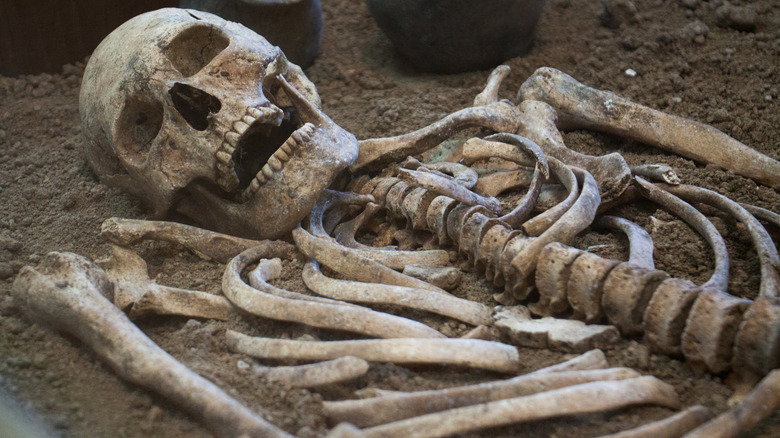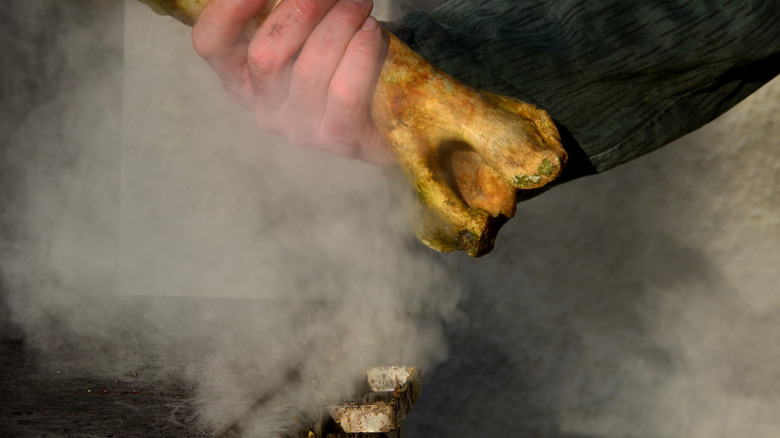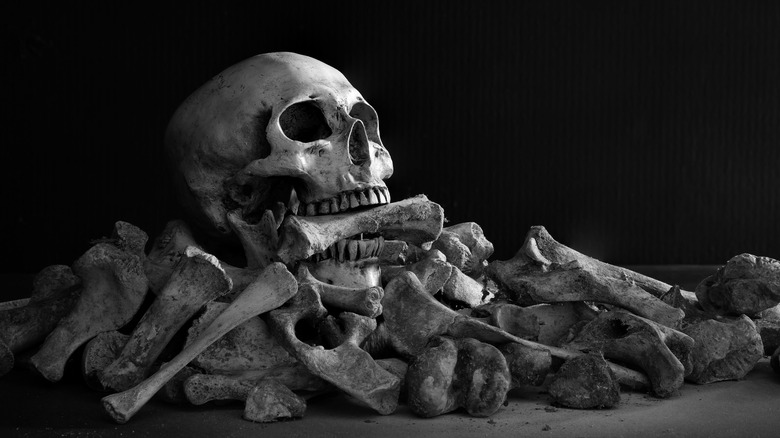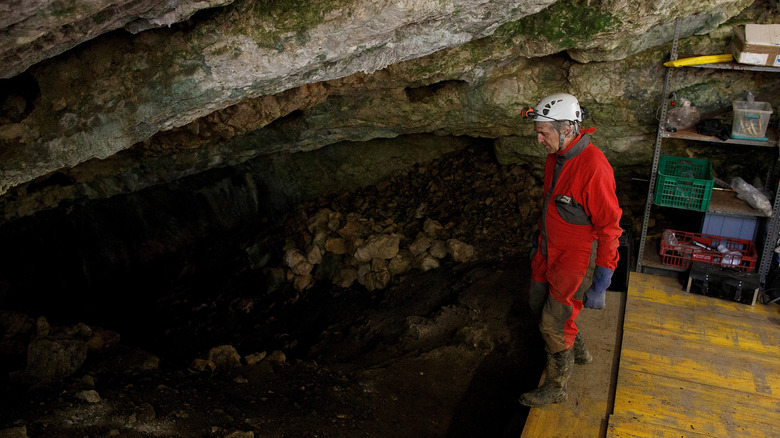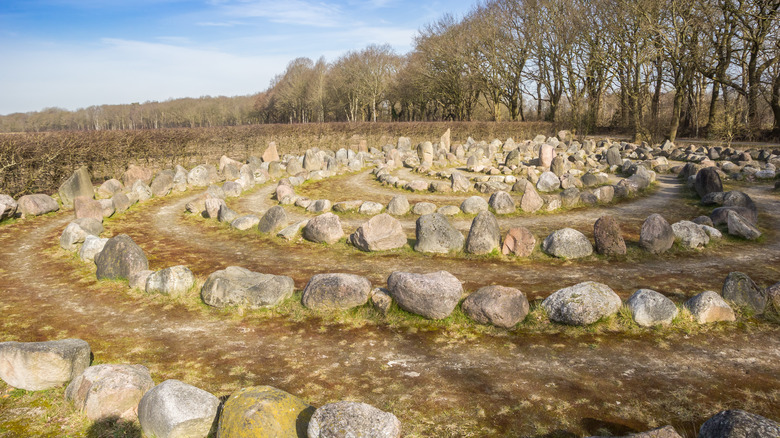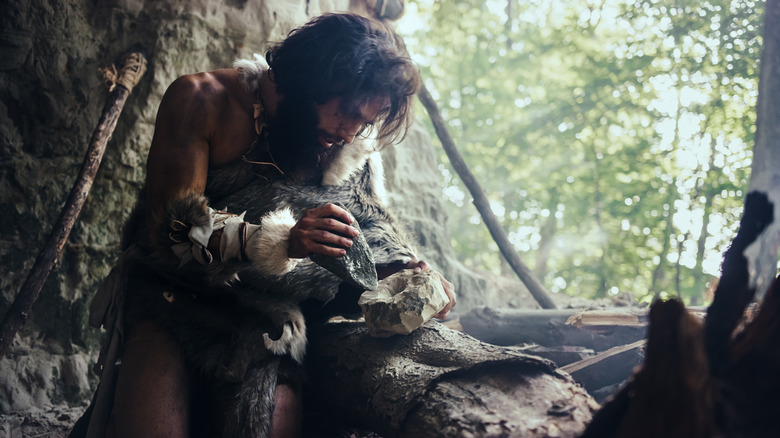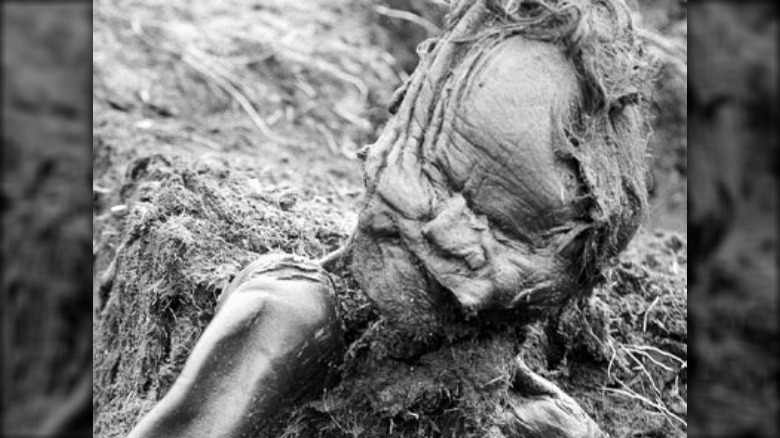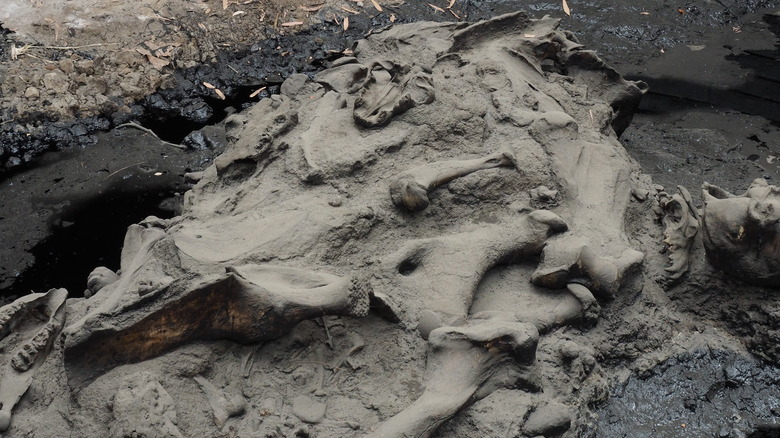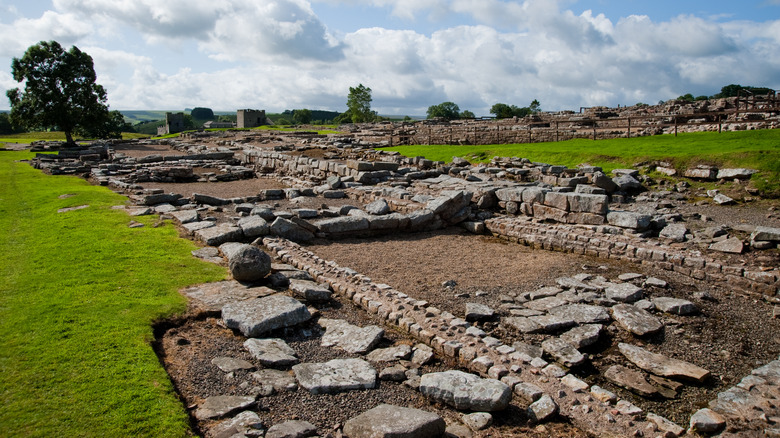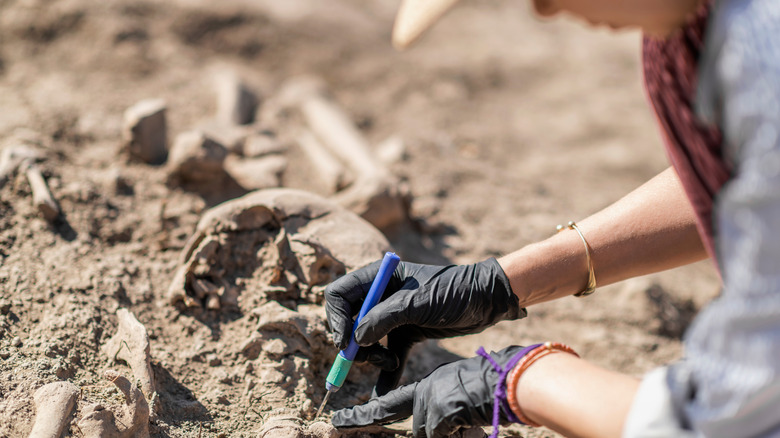Unsolved Murders Of The Ancient World
Primates, it turns out, have a thing for killing each other. That was the conclusion of a study released in 2016, and it's compelling stuff. According to National Geographic, researchers looked at the deaths of 4 million animals and tried to figure out if murder within a species was something shared across the animal kingdom. In short: It isn't.
The study found that the murder rate among mammals was about .3%, with one notable exception. The primate group had a much higher murder rate, and that includes humans at all places along the evolutionary chain. Put that up against the fact that about 60% of all animal species have never been known to murder each other at all, and that's not really great PR for primates — or humans.
That's led University of Colorado Boulder professor Marc Behoff to make an interesting point: "Violence might be deep in the human lineage, but I think people should be very cautious in saying that when humans are violent, they're behaving like nonhuman animals."
In most cases, those nonhumans are just trying to get through the darn day. Humans, on the other hand, have been killing each other for as long as there have been rocks to fight over, and archaeologists have found some pretty fascinating examples of just how our ancient ancestors did — and didn't — get along. The result? Cold cases that are thousands of years old.
Herxheim cannibalism
Archaeologists excavating a Stone Age site in southern Germany were in for a shock: When they uncovered a mass burial pit dating back to around 5000 B.C., they found not just the bones of about 500 people, but bones that bore signs of butchering.
In 2009, project manager Andrea Zeeb-Lanz spoke with Spiegel and explained the scene. The village had been a part of the Linear Pottery culture, and the hundreds of skeletons were at odds with the fact that there were only about 10 houses at the site. Further investigation found that the skeletons didn't belong to local people, and that just made things more confusing.
The skeletons bore marks and breaks similar to the bones of animals that were slaughtered and turned into dinner, with signs that some had even been slow-roasted on a spit. Others seemed to have been skinned, and skulls were broken into bowl shapes. At the same time, though, there were no signs of the sort of injuries that came with large-scale conflict, like arrowheads.
Whatever happened at the site happened in a relatively short period of time. Researchers say that all the burials happened between 5000 and 4950 B.C., but they stress that's that maximum. The only thing archaeologists have are theories: Did something happen at the site that made people willing to go there to be sacrificed and cannibalized? Who was behind the slaughter of hundreds of people?
The execution of 41 ancient people
When the burial pit was first unearthed during a 2007 construction project, National Geographic says the first thought was that they were victims of either the Balkan conflict or World War II. As the story unfolded, it turned out they were much, much older than that.
The 41 people buried in a mass grave in what's now Croatia were dumped there around 6,200 years ago, along with some broken pieces of pottery that helped pinpoint them as being a part of the Lasinja culture. Not much is known about these ancient people, but archaeologists have been able to determine that the final moments of these 41 individuals were agonizing. Each of the skeletons — including those of six children — bore evidence of multiple injuries, including stab wounds and fractures resulting from severe blunt force trauma. None of the wounds were defensive, and some bore signs of some seriously devastating overkill.
Whatever happened there, it was fueled by unstoppable rage.
Archaeologists quickly came to the conclusion that this was some sort of targeted, mass execution, but they're not sure who the killers were, or why these 41 people were murdered. The killers took their weapons with them, and to make this even stranger, the victims were — for the most part — unrelated, although all had genetic ancestry traced back to what's now Turkey.
The Pit of Bones body
National Geographic calls it the "World's Oldest Murder Mystery," and it's safe to say that this one is never going to be solved.
The victim was discovered in the eerily-named Sima de los Huesos (Pit of Bones, pictured) in Spain. It's a fascinating archaeological site even without the murder, as researchers have found it's the final resting place for around 28 individuals who were somewhere between Neanderthals and modern humans. It's one of those finds that makes the scientific community say, "Hold on a minute ... repeat that?" and it turns out that criminologists would like this one, too.
The murder victim had been laying where he was thrown for a shocking 430,000 years, and paleontologists from the Instituto de Salud Carlos III say they're pretty confident it was murder. The killing blows left behind two identical skull fractures, which made it unlikely to have been an accident. The body was then thrown down 43 feet into the cave, and this death was a sharp contrast to the fate of other bodies found there: The others were of different ages, with some showing signs of conditions that would have made daily life impossible without a caregiver. The fact that the mysterious murder victim's wounds hadn't even started to heal made it clear: No one ever wanted them to be discovered.
The Yde Girl
The remains of the young woman that would become known as the Yde Girl were discovered in 1897, says History Extra, well-preserved in the unique environment of the peat bogs of the Netherlands.
Analysis told at-a-glance that half of her long, reddish-blonde hair had been ripped out, and she'd been strangled with a piece of her own clothing. It wasn't until more modern forensic analysis techniques were applied that it was discovered she had been laying in the peat bog since sometime in the first century A.D.
She was about 16 years old when she died, and further examination revealed that in addition to being strangled, she had been stabbed, too. Then, in 2019, the Dutch Research Council announced that the case had been solved, but "solved" is perhaps too strong a word.
Archaeologist and bog expert Roy van Beek determined that those who killed her had lived a little over a half mile away from where she had died, and that some had probably been witness to her murder. Details are still up in the air. Van Beek suggests she may have been killed in a ritual sacrifice or had been given a sentence of execution for some unforgivable crime. The fact that no other bog bodies have been recovered from the same area was cited as odd, too: If she had been a ritual sacrifice, wouldn't there have been more? The Yde Girl remains a singular case, and a monument was built in her memory (pictured).
Shanidar 3
Shanidar 3 is the name of one of the skeletons excavated from a cave in northern Iraq. The cave was used as a burial place for thousands of years: Locals buried their dead there from 65,000 to 35,000 years ago, and Shanidar 3? He was something a little different. Rick Potts of the Smithsonian's National Museum of Natural History called him "the Hope Diamond of the Human Origins collection, and we treat it accordingly."
Shanidar 3 was a Neanderthal, and the Neanderthal burials of the cave are fascinating in their own right. Evidence was found of practices like leaving flowers with the dead, and there's something beautiful about that. Less beautiful are the signs of murder writ large on Shanidar 3's remains. His cause of death was betrayed by a deep gash on the left side of his rib cage. It definitely would have resulted in a collapsed lung, and Potts explains that the implication is murder.
Since then, experts have tried to test the theory: Could era-appropriate weapons leave such a wound, and would it kill? Paleoanthropologists have found (via CBS) that the wound is consistent with "a lightweight, long-range projectile weapon," and that's more important than it seems at first glance. Given that only humans are known to have used such weapons, that means humans weren't just coexisting with Neanderthals, they were straight-up killing them.
Grauballe Man
Like the Yde Girl, the remains of the Grauballe Man were discovered by a peat cutter working in a bog. This one, however, came from Denmark and was only uncovered in 1952, and the eerie, well-preserved state of the body has allowed experts at the Moesgaard Museum to learn some incredible things.
They can tell, for example, that he lost a front tooth when he was somewhere around 5 years old. His last meal was cereals, he had ingested the hallucinogenic ergot fungus, and before that, he'd had a meat-heavy diet. What they haven't been able to determine is why he was killed.
The museum says that one injury — the fractured skull — happened after his death. Another — a broken leg — likely happened around the time he was killed. It seems as though he was hit with a blunt object that shattered his shin and would have taken him off his feet: Was this what led up to his execution? That, they say, came courtesy of an incredibly sharp blade drawn across his throat — probably by someone standing behind him and holding his head back. The cut went all the way through to his spine, and death would have been within minutes.
But why? The Grauballe Man died somewhere between 400 and 200 B.C., and all signs point to him being a perfectly ordinary, Iron Age farmer. Was he selected to be the centerpiece of a human sacrifice? Or did someone have another reason for slitting his throat?
The La Brea Woman
The story of the La Brea Woman is a tricky one, not only because whatever happened to her happened around 9,000 years ago, but because questions over her remains have become a very sticky situation indeed.
The La Brea Woman is, as her name suggests, one of many sets of remains (and, says the Los Angeles Times, the only human one) found in the prehistoric tar pits of Rancho La Brea, California. A cast of her skull was on display at the George C. Page Museum for a long time, where it was attached to a dyed and shortened skeleton of a very real woman of Pakistani descent. Then, in 2004, she was abruptly removed and packed away in storage.
According to LA Weekly, the problems started when a museum volunteer and Santa Monica Police Department sketch artist decided to do a facial reconstruction on the woman and discovered that she belonged to an ancient, Native American tribe. The museum says that the sketch was never supposed to be made public — representatives from the Gabrielino-Tongva Tribal Council say it's "very inappropriate" to display any human remains, and since no group has been concretely linked to the woman, she's remained in storage.
That all means that her future is as uncertain as her past. Considered to be California's oldest murder victim, she was discovered alongside her dog, with skull fractures that indicated she had likely been killed by blunt force trauma. Did she? And who was she?
The Gebelein Man
The Gebelein Man is what's known as a "natural mummy," which is a body that wasn't mummified in the traditional sense but was preserved by the environment. According to the British Museum, the Gebelein Man — named for the area of Egypt where he was discovered — lived sometime around 3500 B.C., and was mummified thanks to centuries in a hot, dry climate.
In 2012, researchers from the museum staff did a CT scan on the mummy and found some incredible details. The man — who was between 18 and 21 years old when he died — was very obviously murdered. The CT scan showed details of the wound that killed him: a deep stab wound in the back.
The wound was so clear and the scans so good that they were also able to determine that the weapon used was probably a dagger with a copper or silver blade, which would have been fairly rare at the time, but not unheard of. They were often worn in a way that allowed for quick access, too, sheathed on an upper arm. They also know that the killer struck with a swing that came down into the man's back from above, and the scans revealed that it was a fatal strike.
Who killed him, and why? The museum posits that it was perhaps a revenge killing, or even a hunting "accident," but also adds that we'll never really know.
Otzi the Iceman
Discovered in 1991 in the mountains bordering Austria and Italy, Otzi died around 5,300 years ago. It wasn't until 2019 that researchers published their bizarre account of his final days (via National Geographic), and it was a panicked handful of hours.
Using different types of plant remains — called bryophytes — found in Otzi's remains, researchers were able to cross-reference the different types with the altitudes they grew at. They found that about 33 hours before he died, he was somewhere around 8,200 feet up. Somewhere between 12 and nine hours before he was killed, he was much lower — about 4,000 feet — and when he died, he was at a height of 10,530 feet.
Whoever Otzi was fleeing, he couldn't run forever: According to the BBC, his ultimate cause of death was only discovered a decade after his remains were. An arrowhead was lodged in his back, in a place where it would have severed a major artery. His death, at least, was fairly quick.
In 2017, Detective Chief Inspector Alexander Horn of the Munich Police Department got a call to come in and look at the evidence on a cold case: Otzi. After examining the body and visiting the murder scene, he determined that not only was it murder, but that he had been taking a break — his own bow beside him — when he was shot in the back. Also telling was a defensive wound on his hand, leading Horn to the conclusion that whoever he had fought days prior, he'd followed him to finish the job.
Georgie
In 2012, the BBC reported on a grisly find from Northumberland's Vindolanda Roman fort (pictured). The barracks were in use throughout the third century, making it likely that the person killed there — who was nicknamed Georgie by the Durham University archaeologists who found the remains — was of the same era. The skeleton was found in a shallow grave, and as if that wasn't bad enough, it was estimated that the victim was about 10 years old.
The university's Trudi Buck explained their interpretation: "I think this is definitely a murder or other unnatural death because of the way the body was deposited. ... possibly, it was hit over the head with something, because we have very good preservation of the body ... but not very much of the head."
There were, however, teeth found with the body, and analysis revealed that Georgie had been born in the Mediterranean and spent their early life there before heading up to Hadrian's Wall. That left several possibilities about who they were: It's suggested they were either a child slave — which Roman soldiers were known to have — or, the son or daughter of a Roman who may have moved his entire family when he was sent to the farthest reaches of the empire.
However Georgie got there, his or her death was — without a doubt — covered up: The Vindolanda Charitable Trust says that it was illegal to bury a person inside the settlement. Whatever happened, it was important that no one knew.
London's 2,500-year-old discovery
Past and present collided in a very literal way when a 2,500-year-old murder victim was uncovered during an archaeological dig preceding the installation of a high-speed rail line in London.
Archaeologist Rachael Wood explained (via BigThink): "He seems to have had his hands tied, and he was face-down in the bottom of a ditch. There are not that many ways you end up that way."
While the cause of death wasn't immediately obvious, it was hoped that with time and further examination, the skeleton would yield more clues about who he was and what had become of him. Interestingly, though, the large-scale dig that went ahead of the rail line project revealed more than 60 other ancient sites of interest, including the remains of an ancient village nearby. It would have been in use from between 3,000 and 2,000 years ago: Was it the dead man's home?
Also nearby would have been an ancient highway that he likely would have been familiar with: the Icknield Way — which 21st century travelers can still walk — was a prehistoric highway that would have been ancient even in the time of the mysterious murder victim.
The Rosemarkie Man
In 2016, archaeologists were working in a series of sea caves on the coast of Scotland when they came across a bizarre set of remains. His head had been crushed, and he had been left in the cave with massive stones pinning down his arms and legs. According to a report from the BBC, genetic analysis suggested he had been an Iron Age man with connections to the Orkney Islands. Facial reconstructions and other studies revealed that he was around 30 years old at the time of his death, had a diet that likely made him part of the upper class, and confirmed that his death had been a brutal one.
The Rosemarkie Man — who was killed around 1,400 years ago — was struck at least five times before his death. Blows shattered his teeth, jaw, and crushed the back of his skull, while the finishing blows were a weapon thrust through his skull from one side to the other, and another thrust, straight down.
For all the violence that was there, archaeologists say his burial was very deliberate. That suggests, they say, he may have been killed as a ritual sacrifice, or was murdered because of an "interpersonal conflict."
